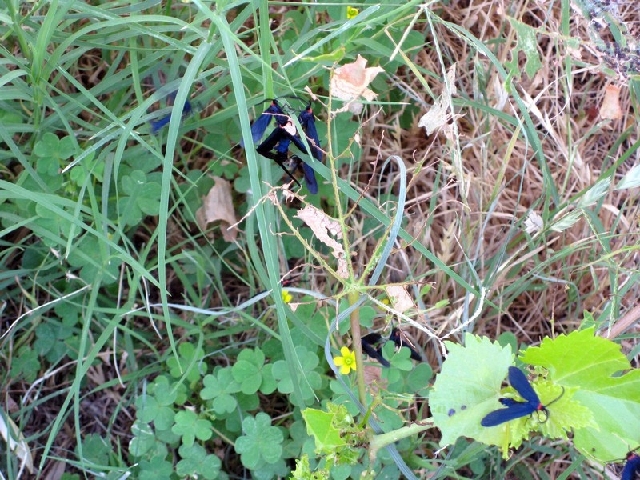Trap pesky gnats with decaying vegetable pieces
Q: I recently transplanted two houseplants and now have gnats coming out of the soil and infecting my entire house. Is there any way to kill these little buggers or do I have to get rid of all the dirt and start over?
A: Fungus gnats can be a serious problem with houseplants as they can feed on plant roots as well as decomposing organic matter left in potting soils. The life cycle of fungus gnats (egg, larva, pupation and adult) is fairly short, perhaps two to three weeks.
The destructive stage is the larva or worm stage. The pesky stage is the adult, which can fly and be bothersome. These stages are overlapping so they will not all be flying at once; some will be in the egg stage, some in the larva stage, some pupating and some flying.
You can attract the larvae living and feeding in the soil to decaying vegetable pieces like small pieces of potato. You can lay pieces about the size of a french fry on the soil surface and the larvae will start feeding on them. You can collect these pieces and dispose of them and it will help get rid of a few of the buggers.
Let me point you in the direction of an organic product that may work for you. This is supposed to be available at hardware stores and home-improvement stores. With a homeowner trade name of Mosquito Bits, it was originally labeled for controlling mosquitoes but is approved for fungus gnats.
This organic product is made from Bt (a bacterium). There have been a few other homeowner products made from Bt for indoor plants, but they have disappeared from many marketplaces I assume because the homeowner didn’t know about them and how to use them.
A word of explanation. As I said, this is a Bt product. I have mentioned Bt in the past, with product names such as Dipel and Thuricide. This one is a different form of Bt. Using the Dipel or Thuricide form of Bt that you would use for grape leaf skeletonizer, tobacco hornworm, tomato fruitworm (insects that are in the order lepidoptera) will not work in this case.
This form of Bt is unique to certain types of insects in the order diptera, such as mosquitoes and fungus gnats. The commercial formulation of this product is called Gnatrol. Apply this product according to the label directions.
I put more information about different types of Bt formulations on my blog.
Q: I wrote to you earlier about my bumpy hybrid Bermuda grass lawn that I do not overseed before the winter. The bumpiness might be more from uneven thatch, thus thin spots. I aerated it several times last year. The lawn has never been as nice as I want. I feel the peak season is short in this climate.
A: Las Vegas sits in what educated turfgrass professionals might call the “transition zone.” The U.S. has three major turfgrass growing regions: cool climates suitable for cool-season grasses such as bluegrass, hot climates suitable for warm-season grasses such as Bermuda grass and this odd area in between these two climates we call the “transition zone.”
Las Vegas sits smack dab inside the transition zone. The transition zone is capable of growing both warm- and cool-season grasses equally poorly. It kind of reminds me of those tools that are eight-in-one; they can do eight different jobs but none of them well.
One benefit of fall overseeding for a green winter lawn is that the process helps eliminate thatch because you must remove the thatch (or dethatch) the lawn sufficiently so that the seed can make contact with the soil for good germination.
Many years ago, Bermuda grass would be burned in the winter to get rid of the dead surface grass. This process removed thatch accumulation. Some types or cultivars of Bermuda grass are used for feeding animals. It is still recommended that Bermuda grass hay fields be burned for numerous reasons including thatch removal and reduction of insects and diseases.
Years ago, Bermuda grass lawns also were burned in the rural areas of Nevada and probably still are in some places. We didn’t have thatch when Bermuda grass was burned in the late winter. Because we cannot burn dead grass anymore because of local ordinances and safety issues, this dead grass remains and interferes with having a good-looking lawn.
We substitute a gasoline-driven machine (called a dethatcher, vertical mower or verticutter depending on who you are talking to) instead of burning the dead Bermuda grass. This, of course, uses petroleum, adds pollutants to the air and leaves this Bermuda grass thatch, that we have harvested from dethatching, for dumping somewhere like a landfill. Or burned. Aren’t we smart?
For those of you who can access my blog and want to see more pictures of the grape leaf skeletonizer, please take a look at some pictures sent to me by a reader from Phoenix. He did a great job taking pictures of this blue-black moth laying eggs, the egg masses on the leaves and hatching larvae. It is four or five posts down so you have to scroll down to see them.
Bob Morris is a horticulture expert living in Las Vegas and professor emeritus for the University of Nevada. Visit his blog at xtremehorticulture.blogspot.com.


















